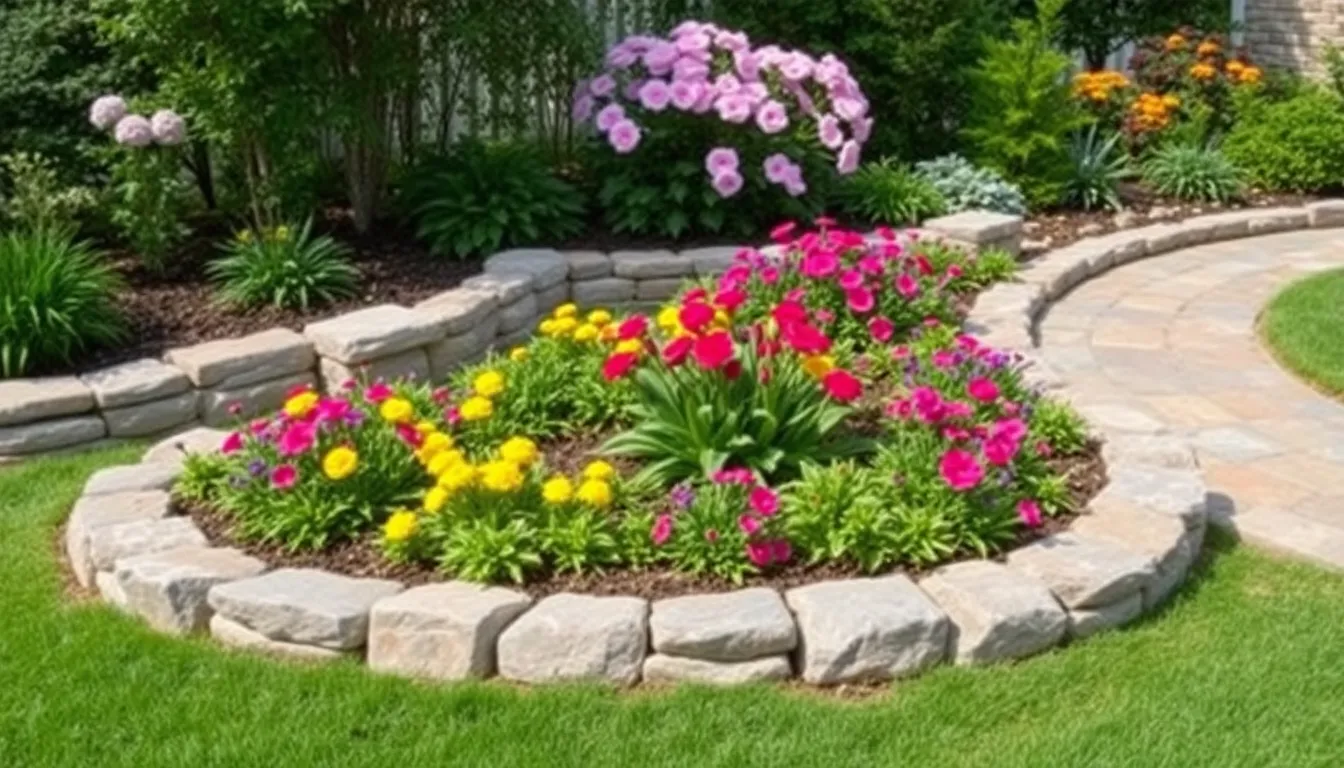When it comes to landscaping, stone edging is like the cherry on top of a sundae—essential and oh-so-delicious. It not only defines garden beds and pathways but also adds a touch of elegance that makes neighbors green with envy. Picture those perfect lines and the way sunlight dances off the stones. Who knew a little rock could pack such a punch?
Stone Edging For Landscaping
Stone edging adds significant value and appeal to landscaping projects. It creates structure while delivering functional benefits.
Aesthetic Appeal
Stone edging enhances the visual aesthetics of gardens and pathways. Various stone types and colors provide versatility in design, allowing for personalized expression. Curved or straight lines define spaces clearly, making any garden more attractive. Textures of natural stones also contribute by creating a dynamic appearance. The reflection of light on polished stones adds vibrancy to landscapes. It’s common for homeowners to notice how organized features draw positive attention from guests. This beauty elevates the overall ambiance of outdoor areas, making them more inviting.
Durability and Longevity
Durability characterizes stone edging, ensuring it withstands harsh weather conditions. Unlike wood or plastic, stone does not rot or degrade over time. Longevity is a primary reason many choose stone for landscaping projects. For instance, proper installation can last decades with minimal maintenance. Stones resist pests and prevent the spreading of weeds effectively. These qualities lead to long-term cost savings, as replacement and repair become unnecessary. Homeowners can enjoy their landscapes without worrying about frequent restoration. Stone edging stands firm, offering both beauty and practicality throughout the seasons.
Types Of Stone Edging

Stone edging comes in various types, suited for diverse landscaping needs. Both natural and manufactured options provide distinct advantages.
Natural Stone
Natural stone edging consists of materials like granite, limestone, and slate. Durability characterizes this type, ensuring resistance to weathering conditions. Natural stones offer unique colors and textures, allowing for a customized look that complements different garden styles. Each piece typically varies in shape and size, contributing to a more organic aesthetic. Installation of natural stone may require professional assistance, given its weight and need for precise placement. Maintenance involves occasional cleaning, while its longevity reduces the frequency of replacement.
Manufactured Stone
Manufactured stone edging mimics the appearance of natural stones while presenting additional benefits. Uniform shapes and sizes make installation straightforward, even for DIY enthusiasts. This type often provides a lightweight alternative, simplifying transport and placement. Various colors and styles allow homeowners to match their existing landscaping seamlessly. Some options even incorporate environmentally friendly materials, promoting sustainability. The cost-effectiveness of manufactured stone edging appeals to budget-conscious individuals. Maintenance remains minimal, as many products resist staining and fading effectively.
Installation Process
Installing stone edging involves careful preparation and precise placement. Following a systematic approach ensures a successful and durable outcome.
Preparing The Site
Start by marking the edge layout using stakes and string. Ensure the desired shape is visible and accurate. Next, remove any grass, weeds, or debris from the outlined area. Dig a trench to accommodate the stones, ensuring it’s deep enough for stability. The trench depth may vary based on stone thickness, but generally, a depth of 4 to 6 inches suffices. After that, compact the soil at the bottom to create a stable base. This preparation phase lays the groundwork for successful installation.
Laying The Stones
Begin laying the stones at one end of the trench. Adjust each stone as you go, ensuring they fit snugly together. Use a level to check for evenness and alignment frequently. Make adjustments as necessary to maintain a straight line or desired curve. Next, backfill soil around the stones to secure them in place, providing additional support. Consider adding gravel or sand for improved drainage. Finally, tap the stones gently with a rubber mallet to settle them securely into the trench. This process establishes both visual appeal and functionality in the landscape.
Maintenance Of Stone Edging
Maintaining stone edging ensures longevity and aesthetics in landscaping. Regular attention prevents issues and keeps the outdoor space looking pristine.
Regular Cleaning
Cleaning stone edging maintains its visual appeal. Debris like leaves and dirt can accumulate, detracting from the overall look. Using a broom or a leaf blower removes loose materials easily. A mixture of water and mild detergent cleans stubborn stains. Scrubbing with a soft brush helps dislodge grime without damaging the stones. Regular cleaning enhances the colors and textures, ensuring that the edging continues to complement the landscape design perfectly.
Repairing Damage
Addressing damage promptly preserves the integrity of stone edging. Cracks or shifts may occur due to shifting soil or extreme weather conditions. Inspect edging regularly for any signs of wear. Replacing dislodged stones restores the structure and maintains a neat appearance. Proper installation reduces the risk of movement, though some issues may still arise. Filling gaps with additional gravel or soil can stabilize the stones and prevent further damage. A proactive approach to repairs keeps the landscaping looking well-maintained and inviting.
Conclusion
Stone edging is more than just a decorative element; it’s a vital component that brings structure and elegance to any landscape. By choosing the right type of stone and following proper installation techniques, homeowners can create visually appealing borders that enhance their outdoor spaces.
With minimal maintenance required and the ability to withstand the elements, stone edging proves to be a practical investment. Its versatility allows for creative designs that reflect personal style while defining garden beds and pathways.
Incorporating stone edging into landscaping not only elevates the aesthetic appeal but also adds lasting value to the property. Homeowners can enjoy a beautifully manicured yard that impresses all who visit.

